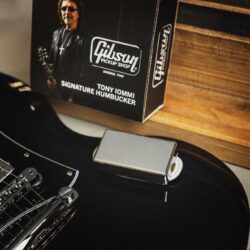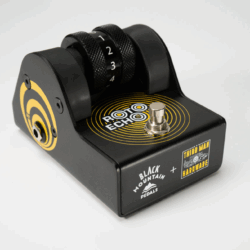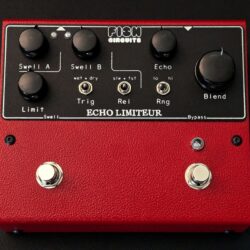INTRODUCING THE ROTO-ECHO
Jack White’s Third Man Hardware and Black Mountain Designs teamed up to release the Roto-Echo, a new delay pedal designed to give guitarists hands-free control over their delay parameters, in real time, while they perform. At first glance, the Roto-Echo looks like a familiar-sized delay stompbox. It easily fits on a standard pedalboard. On top […]
The post INTRODUCING THE ROTO-ECHO first appeared on Vintage Guitar® magazine.

Guitar phenom Muireann Bradley plays “When the Levee Breaks” live at Guitar World HQ
Irish guitar phenom Muireann Bradley visited GW HQ in NYC to play “When the Levee Breaks,” a Kansas Joe McCoy & Memphis Minnie tune famously covered by Led Zeppelin in…
Read more »
Tony Iommi Signature Humbucker
The Gibson Pickup Shop Artist Collection pickups are created in collaboration with some of the world’s most influential artists, including legends who shaped the sounds that built the foundation of modern music, as well as some of today’s most innovative players who continue to shape the sound of music across genres and influence musicians worldwide. Gibson is proud to continue its partnership with Tony Iommi, the legendary guitarist of Black Sabbath, with the launch of the Tony Iommi Signature Humbucker™, available worldwide on www.gibson.com.Tony Iommi’s legendary guitar work, powerful sound, and groundbreaking albums laid the foundation for heavy metal and inspired countless other genres. His music and his legacy are celebrated across the globe, and in the late 90s, Gibson teamed up with Tony to create their very first signature pickup. Today, that original Gibson signature humbucker makes its long-awaited return.
The Tony Iommi Humbucker features an exclusive configuration of powerful ceramic and Alnico 2 magnets, along with unique windings, that give it the incredible tone and sustain that have helped make Tony’s work with Black Sabbath instantly recognizable. Thunderous tone and incredible sustain, with crystal clarity, even in full distortion, the Tony Iommi Humbucker is fully wax-potted and epoxied for absolute protection against unwanted feedback. The 4-conductor wiring allows for series, parallel, and split coil operation.“I’m really excited that Gibson’s bringing back my signature humbucker, they were getting pretty hard to find!” says Tony Iommi. “This pickup came about after a lot of time spent in Nashville, just experimenting with different setups to get that perfect tone and sustain from my favourite guitars. We had to make sure it worked with my light gauge strings and low tunings, but still pack a punch, and the result has got some serious output. They’re on my signature guitars too, and I couldn’t be more pleased with how they turned out.”
“I’d personally installed these on one of my Gibson guitars 15 years ago, and I was blown away with the distinct Tony Iommi and Black Sabbath sound I was able to get out of them,” explains Cesar Gueikian, President and CEO of Gibson. “They have such a great, clean look with the unique pickup cover, and we are excited to bring the Rifflord’s signature humbucker back as we continue to pay tribute to Tony.”
“It’s great to have the first signature pickup from Gibson back, and there really isn’t a more fitting artist than Tony Iommi,” says Lee Bartram, Head of Commercial and Marketing EMEA at Gibson. “Tony is synonymous with the Gibson SG™, but now the volume, presence, and overall power he produces through his playing can be experienced in other models too, whether at home, in the studio, or on stage. Thanks to Tony for his continued support and trust; these pickups are the result of our constant collaboration, and we look forward to what’s next for our partnership.”

Third Man Hardware and Black Mountain Designs Introduce the Roto-Echo Delay
Jack White’s Third Man Hardware and Black Mountain Designs have teamed up to release the Roto-Echo, a new delay pedal designed to give guitarists hands-free control over their delay parameters, in real time, while they perform.At first glance, the Roto-Echo looks like a familiar-sized delay stompbox. It’s a foot-controlled delay pedal built for the stage and easily fits on a standard pedalboard. On top of the pedal, there’s a roller wheel—smooth, weighted, and spring-loaded. The player can assign that wheel to control blend, feedback, and delay time via a three-way toggle switch. The core delay circuit is based on the PT2399 chip, offering warm, gritty echoes from 60MS a slapback to roughly 588MS repeats.What makes the Roto-Echo different is how those parameters can be shaped in the moment. The roller wheel responds to foot motion, and with practice, players can perform swells, shifts, or rhythmic changes in their delay sound as they play—no need to crouch down or dial knobs mid-song or rely on presets. Sound manipulation typically reserved for the studio is now easy to perform live.Specs at a glance: • Delay Time: 30ms to ~600ms (PT2399-based) • Roller Wheel: Assignable to Time, Feedback, or Blend. Rated for full body weight. • Power: 9V DC (center negative) • Current Draw:
Read more »
Share Your Opinion on Amp Modeling Pedals for a Chance to Win
We’d love to hear your thoughts on amp modeling pedals. Answer our short survey and you’ll be automatically entered for your chance to win! Don’t worry, it will only take a couple of minutes.Click here to share your opinion and be entered!The Prize: Fender Vintera II ’60s Telecaster Electric Guitar – Sonic Blue
Revive the timeless sound of the ’60s with the Vintera® II ’60s Telecaster® and experience the iconic looks, inspiring feel and incomparable tone that only a Fender can deliver.The Vintera® II ’60s Telecaster® features an alder body and a maple neck with rosewood fingerboard for classic Fender tone that’s full of punch and clarity. The early-’60s “C” shape neck is based on a classic ’60s profile for an intuitive and inviting feel, while the 7.25″ radius fingerboard with vintage-tall frets provides vintage comfort with ample room for big bends and expressive vibrato. Under the hood, you’ll find a pair of vintage-style ’60s pickups that deliver all the crystal-clear chime and raw, steely twang that made Fender famous. The vintage-style 3-saddle bridge with slotted steel saddles offers authentic ’60s twang, while vintage-style tuning machines provide classic looks with a finer gear ratio and enhanced tuning stability to complete the package.Experience the unmistakable vintage feel and unmatched sound of a classic Fender with the Vintera® II ’60s Telecaster® today and start making music history!
Read more »Blast Worship: Internal Rot
Melbourne blasters Internal Rot do not disappoint on a new split with fellow face-melters Mutilated Cop.
The post Blast Worship: Internal Rot appeared first on Decibel Magazine.

Do These New Fender Guitars Beat Your Vintage Favorite?
Vintage spirit and looks live in a Telecaster and Stratocaster with contemporary refinements at every turn.Fender American Ultra Luxe Vintage 50s TelecasterRepresenting the pinnacle of innovation and craftsmanship, Fender American Ultra Luxe sets the benchmark for premium electric instruments. The new American Ultra Luxe Vintage series takes it a step further, showcasing the finest of Fender heritage – where timeless classics meet uncompromising modern refinement. The American Ultra Luxe Vintage 50s Telecaster features premium ash with carved contours that complement the aged Heirloom™ lacquer finish. Built for precision performance, the quartersawn maple neck with a Modern ‘D’ shape and Ultra rolled edges features medium jumbo stainless- steel frets, Luminlay side dots, and a Graph Tech TUSQ nut. Each instrument features a tapered neck heel to ensure unparalleled access to the higher register. Under the hood, Pure Vintage ’51 Tele pickups deliver classic Fender tones, from sparkling cleans to rich, expressive leads. Performance hardware includes a precision-engineered 6-saddle string-though-body bridge with brass block saddles and deluxe locking short post tuners for quick string changes and superior tuning stability. The American Ultra Luxe Vintage 50s Telecaster delivers flawless modern performance with distinctive classic design. Available in Butterscotch Blonde and White Blonde.Fender American Ultra Luxe Vintage 60s StratocasterRepresenting the pinnacle of innovation and craftsmanship, Fender American Ultra Luxe sets the benchmark for premium electric instruments. The new American Ultra Luxe Vintage series takes it a step further, showcasing the finest of Fender heritage – where timeless classics meet uncompromising modern refinement. The American Ultra Luxe Vintage 60s Stratocaster features premium alder with carved contours that complement the aged Heirloom lacquer finish. Built for precision performance, the quartersawn maple neck with a Modern ‘D’ shape and Ultra rolled edges features medium jumbo stainless- steel frets, Luminlay side dots, and a Graph Tech TUSQ nut. Each instrument features a tapered neck heel to ensure unparalleled access to the higher register. Under the hood, Pure Vintage ’61 Strat delivers classic Fender tones, from sparkling cleans to rich, expressive leads. Performance hardware includes a precision-engineered 2-Point American Ultra synchronized tremolo with polished stainless steel block saddles, cold rolled steel block, and deluxe locking tuners for quick string changes and superior tuning stability. The American Ultra Lux Vintage 60s Stratocaster delivers flawless modern performance with distinctive classic design. Available in Ice Blue Metallic and Surf Green.
Read more »
Cheap Trick Announce New Album, All Washed Up, Out Via BMG November 14
The one and only Cheap Trick have announced today’s premiere of their new single. The infectious and anthemic “Twelve Gates” is available now at all DSPs and streaming services. The song heralds the Rock n’ Roll Hall of Famers’ eagerly anticipated 21st studio album, All Washed Up, arriving via BMG on Friday, November 14 digitally as well as on standard black vinyl and CD. A limited-edition exclusive “Orange Marble” LP variant of the album, limited to 1,000 units, will be available to pre-order via the band’s new D2C store.“Our newest single release, ‘Twelve Gates,’ from the 2025 LP All Washed Up, is one of our best yet,” says bassist Tom Petersson. “ I really love how this song came out. It’s one of my favorites on the album.”All Washed Up was produced by the band and Julian Raymond. It was mixed by Chris Lord Alge and recorded at various studios in Nashville (Sound Emporium Studios, Blackbird, Love Shack, Zen) as well as in LA (Sweetzerland Studios) through 2024.”Just one more great album from the best rock band in the world,” says lead singer/guitarist Robin Zander.Tracklisting:Cheap Trick have also announced Fall 2025 tour dates to add to their gloriously never-ending run. The new dates start October 12 at Oxford, AL’s Oxford Performing Center and conclude at Vibrant Music Hall in Waukee, IA on December 7. Tickets are on sale now. The complete itinerary is below.CHEAP TRICK – TOUR 2025AUGUST20 – Rhinebeck, NY – Dutchess County Fair21 – Syracuse, NY – New York State Fair28 – Salem, OR – Oregon State Fair – LB Day Amphitheatre31 – Pueblo, CO – Colorado State FairSEPTEMBER19 – Menlo Park, CA – The Guild Theatre20 – Napa, CA – Blue Note Napa Summer Sessions at Meritage Resort29 – Osaka, JP – Grand CubeOCTOBER1 – Tokyo, JP – Budokan11 – Miramar Beach, FL – Seascape Resort Golf Club & Tennis Resort12 – Oxford, AL – Oxford Performing Arts Center *21 – Huntington, NY – The Paramount *22 – Bethlehem, PA – Wind Creek Bethlehem – Wind Creek Event Center *24 – Atlantic City, NJ – Hard Rock Live*25 – Lynn, MA – Lynn Memorial Auditorium *NOVEMBER9 – Chandler, AZ – Wild Horse Pass Hotel & Casino – The Showroom *11 – Monterey, CA – Golden State Theatre *14 – Reno, NV – Grand Sierra Resort and Casino *16 – Turlock, CA – Turlock Community Theatre *18 – Anaheim, CA – HONDA Center +23 – Seattle, WA – Climate Pledge Arena +DECEMBER2 – Omaha, NE – Baxter Arena +4 – Green Bay, WI – Reach Center +5 – Madison, WI – The Sylvee *7 – Waukee, IA – Vibrant Music Hall ** Newly Announced Date+ with Heart
Read more »
Full Album Stream: Prayer Group –Strawberry
Hear bruising secular secular noise rockers, Prayer Group, whip out their big ten-inch . . . record, Strawberry.
The post Full Album Stream: Prayer Group –Strawberry appeared first on Decibel Magazine.

Fish Circuits Echo Limiteur Review
Montreal’s Fish Circuits, helmed by builder Mike Poisson, has made quite a splash the past few years with colorful offerings like the Model One, Lunatique, and most recently the Astronomie, a dynamic reverb that can swell in and out depending on settings and playing style. Fish Circuits’ first delay, the Echo Limiteur, comes in a characteristically sleek box that, like all their others, could be used as a bludgeon. But with an analog delay, a second digital delay, and a limiter, its utility as a tool for defense pales in comparison to the sounds its circuitry produces.Swell Set Of Features The Echo Limiteur consists of two delay modes, swell A and swell B. Swell A is a straightforward delay channel, governed just by the global echo and blend knobs and the range switch. The last of these shortens or lengthens the delay-time range of the echo control. “Hi” gives you longer delay times (up to 1150 milliseconds) and slightly cleaner repeats courtesy of the digital PT2399 chip, while “Lo” gives you lower-fidelity repeats and a shorter sweep of possible delay times (up to 650 milliseconds). Both swell A and swell B knobs control the number of repeats.The limiter affects the swell B mode alone. It limits the delay feedback and can be triggered dynamically by the dry signal, wet signal, or both. This effectively means you can use infinite repeats that won’t overpower your dry sound and/or infinite repeats that reset each time you pick a note or chord. The release switch tells the limiter how quickly to lay off the limiting, while the trigger lets you decide whether a dry, wet, or combined signal activates the limiter. Limit, meanwhile, controls the sensitivity of the trigger: All the way counter-clockwise, it’s nearly non-existent, while fully clockwise, the slightest noise in your signal will trigger the limiter, chopping the repeats. All three controls are extremely interdependent. Got it? Probably not. You have to physically experience the responses of each of these features to really grasp how they manipulate the signal. And there will be some who wish the Echo Limiteur’s switch-controlled functions were more deeply tweakable. Not me though; we are in the age of the pedal-builder-as-auteur, and I loved allowing my playing to be guided by Poisson’s preset parameters. Push it to the LimitPlaying through the dynamic-delay side of the Echo Limiteur immediately expands the possibilities of your instrument. Because it responds to playing dynamics, it’s not exaggerating to say there are endless ways to apply the Echo Limiteur. You can set it for a cavalcade of tight, spiraling repeats that cut out sharply the second you play another note, or you can tone down the limiter so that it only cuts off the delay when you play hard. In this arrangement, you can pick delicately beneath a bed of towering, oscillating feedback and pull the plug on the delay just by strumming a bit harder. If you want to bail on the dynamic aspect entirely, you just hit the left footswitch and you’re in regular delay land (the right one is the on/off switch).Thanks to the analog MN3005 chip, the repeats are foggy, greasy, and frayed. But the augmented repeat lengths—courtesy of the digital PT2399 chip—extend the pedal’s utility. My only gripe is that I wish the Echo Limiteur was capable of even shorter, tighter delay times. It bottoms out at roughly 100 milliseconds, which means you can’t use the dynamic limiter with the most slashing and jittery machine-gun repeats.The VerdictThe Echo Limiteur already feels destined to be a classic. The potential applications in live contexts, in particular, are thrilling to consider, and I’m sure that in the years to come, we’ll hear new music defined by the Echo Limiteur’s many voices.
Read more »